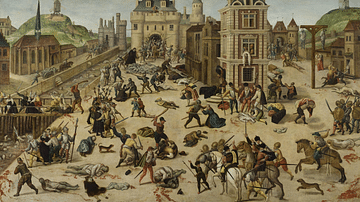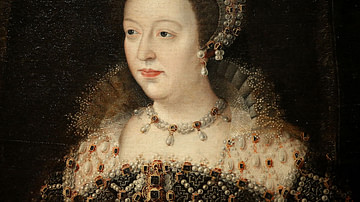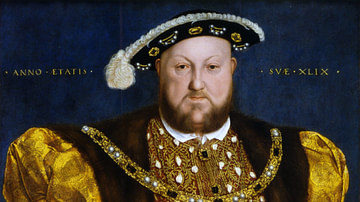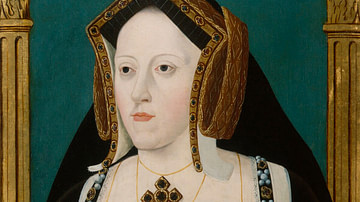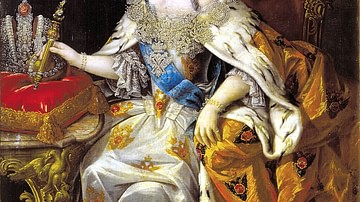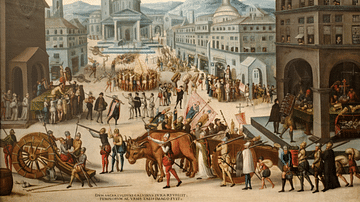Margaret of Valois' eyewitness account of St. Bartholomew's Day Massacre is among the most famous and the only written record of the event left by a member of the royal family of France at the time. Her account appears in her memoirs as Letter V, describing the night before the massacre and the events she witnessed during it.
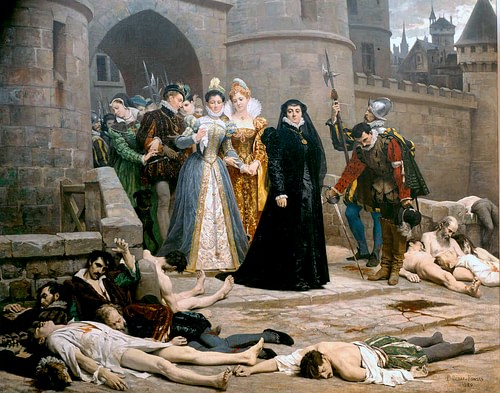
Margaret of Valois (l. 1553-1615) was the daughter of Catherine de' Medici (l. 1519-1589) and King Henry II of France (r. 1547-1559). She was betrothed to Henry of Navarre (later King Henry IV of France, l. 1553-1610) in an arranged marriage intended to encourage reconciliation between Catholics and Protestants (Huguenots) in France who had been engaged in armed conflict with each other since 1562. The marriage, arranged by the Catholic Catherine de' Medici and Henry's mother, the Protestant queen of Navarre, Jeanne d’Albret (l. 1528-1572), was envisioned as a grand affair celebrating religious tolerance through the union of the Catholic bride and Protestant groom.
The wedding was set for 18 August 1572, drawing large crowds of Protestants to the overwhelmingly Catholic city of Paris, including the major Protestant leaders. Among these was Henry of Navarre, the bridegroom, Henry I de Bourbon, Prince of Condé (l. 1552-1588), and Gaspard II de Coligny, Admiral of France (l. 1519-1572). A few days after the wedding, on 22 August, an attempt was made on Coligny's life, wounding him, and the Protestant leaders demanded some appropriate response from the Catholic King Charles IX (r. 1560-1574), the city council, and Catherine de' Medici. They received assurances the assassin would be caught and punished while, at the same time, the king, Queen Mother, and council agreed to a plan to assassinate all the Protestant leaders as they feared a major uprising to avenge Coligny.
The plot was formalized on the night of 23 August 1572 (sometimes given as the start of the massacre) and put into effect the next day beginning with the murder of Coligny and the other leaders and then spreading to include any Protestants. It is estimated that approximately 5,000 Protestants were murdered in Paris in the days following the first killings, with numbers possibly as high as 25,000-30,000 overall once news of the Parisian massacre spread and other cities followed suit. There are a number of eyewitness accounts of the event from different areas of Paris, but only Margaret's by a member of the royal family, which details what happened in the palace during the massacre. The hoped-for reconciliation never materialized, and the French Wars of Religion would continue until 1598.
Background
Tensions between Protestants and Catholics had been growing since 1534 when Francos I of France (François I, r. 1515-1547) reversed his policy of tolerance toward Protestants following the event known as the Affair of the Placards when anti-Catholic messages were posted throughout Paris and other cities. Francis I's son, Henry II, continued his father's persecution of Protestants until he was mortally wounded in a jousting tournament and died in 1559. He was succeeded by his 15-year-old son Francis II of France (François II, r. 1559-1560), who, though old enough to rule on his own, was controlled by his mother, Catherine de' Medici.
Catherine invited two powerful Catholic nobles of the Guise family, Francis, Duke of Guise (l. 1519-1563), and his brother Charles, Cardinal of Lorraine (l. 1524-1574), to counsel the king, and they soon isolated him from his former counselors, who included Louis de Bourbon, Prince of Condé (l. 1530-1569, father of Henry I de Bourbon) and Admiral Coligny. In response, these men joined in what came to be known as the Amboise Conspiracy, a plot to kidnap Francis II to neutralize the influence of the Guise brothers, in 1560. The plot was uncovered, most of the conspirators were jailed or executed (Condé jailed, Coligny left untouched), and the Guise used the event in anti-Protestant propaganda.
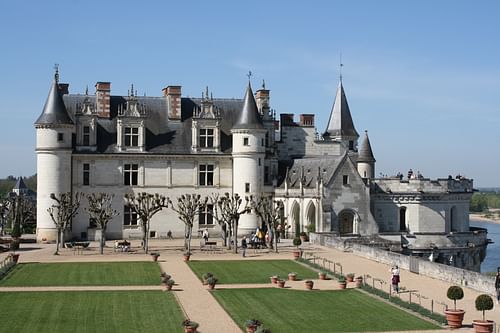
Francis II died in 1560 and was succeeded by his brother Charles IX. In 1562, Francis, Duke of Guise, set off the French Wars of Religion (1562-1598) by slaughtering members of a Protestant congregation at the Massacre of Vassy, and Louis de Bourbon (who had been released from prison) responded by taking the city of Orléans for the Protestants. The first three French Wars of Religion killed both Condé and Francis, Duke of Guise, as well as thousands of others, and by 1572, there was simmering resentment on both sides.
Marriage & Massacre
Catherine de' Medici proposed the arranged marriage to Jeanne d'Albret in an effort to ease these tensions by joining a Catholic and Protestant in matrimony. Jeanne d'Albret died of natural causes in June of 1572, and rumors spread among Protestants that she had been poisoned by Catherine, heightening tensions. The extravagance of the royal wedding only made the situation worse as harvests had been poor that year and taxes were high, so the common people were already resentful without the addition of religious disagreements and conspiracies of political intrigue and murder.
With tensions already high, Admiral Coligny was wounded in an assassination attempt on 22 August, and fearing reprisals, the city council, Catherine, and Charles IX agreed on the plan to execute all the other Protestant leaders the night of the 23rd. This plan was put into effect the next morning with the assassination of Coligny and then of the other prominent Protestants. The commoners, following the lead of the royal soldiers, then began massacring every Protestant or Protestant sympathizer in the city. Many Catholics, horrified by the slaughter, hid Protestants in their basements or attics.
A number of Protestants – including Henry of Navarre and Henry I de Bourbon – promised to convert to Catholicism to save themselves (then ignored their pledge once they were safely out of the city). Still others managed to disguise themselves as Catholics (by carrying a Catholic prayer book or by similar means) or hid themselves as best they could. There was no escaping the city because Charles IX had ordered the gates closed and locked the night before and chains strung across the streets to prevent any large-scale movements.
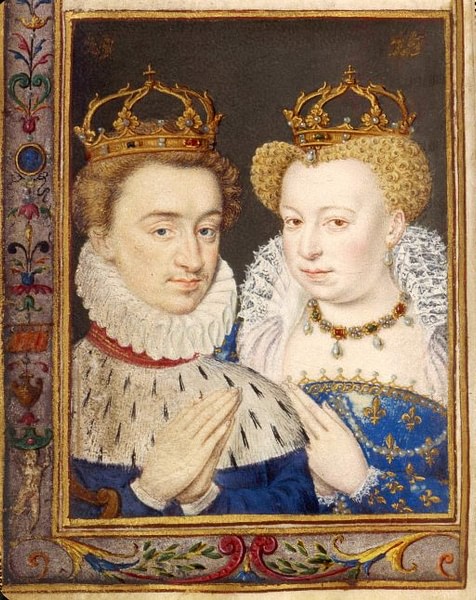
The Text
The following account begins with the night of the 23rd and goes into the 24th and afterwards. The names in the last sentence of the first paragraph were all Protestant leaders killed in the massacre. The M. de Guise mentioned by Margaret is Henry I, Duke of Guise (l. 1550-1588), son of Francis, Duke of Guise. Margaret's sister, whom she refers to as Lorraine, is Claude of France, Duchess of Lorraine (l. 1547-1575), who had returned to Paris for the wedding. The text is taken from The Memoirs of Marguerite de Valois, pp. 39-43, Letter V:
King Charles, a prince of great prudence, always paying a particular deference to his mother, and being much attached to the Catholic religion, now convinced of the intentions of the Huguenots, adopted a sudden resolution of following his mother's counsel, and putting himself under the safeguard of the Catholics. It was not, however, without extreme regret that he found he had it not in his power to save Teligny, La Noue, and M. de La Rochefoucauld.
He went to the apartments of the Queen his mother, and sending for M. de Guise and all the Princes and Catholic officers, the "Massacre of St. Bartholomew" was that night resolved upon.
Immediately every hand was at work; chains were drawn across the streets, the alarm-bells were sounded, and every man repaired to his post, according to the orders he had received, whether it was to attack the Admiral's quarters, or those of the other Huguenots. M. de Guise hastened to the Admiral's, and Besme, a gentleman in the service of the former, a German by birth, forced into his chamber, and having slain him with a dagger, threw his body out of a window to his master.
I was perfectly ignorant of what was going forward. I observed every one to be in motion: the Huguenots, driven to despair by the attack upon the Admiral's life, and the Guises, fearing they should not have justice done them, whispering all they met in the ear.
The Huguenots were suspicious of me because I was a Catholic, and the Catholics because I was married to the King of Navarre, who was a Huguenot. This being the case, no one spoke a syllable of the matter to me.
At night, when I went into the bedchamber of the Queen my mother, I placed myself on a coffer, next my sister Lorraine, who, I could not but remark, appeared greatly cast down. The Queen my mother was in conversation with some one, but, as soon as she espied me, she bade me go to bed. As I was taking leave, my sister seized me by the hand and stopped me, at the same time shedding a flood of tears: "For the love of God," cried she, "do not stir out of this chamber!" I was greatly alarmed at this exclamation; perceiving which, the Queen my mother called my sister to her, and chid her very severely. My sister replied it was sending me away to be sacrificed; for, if any discovery should be made, I should be the first victim of their revenge. The Queen my mother made answer that, if it pleased God, I should receive no hurt, but it was necessary I should go, to prevent the suspicion that might arise from my staying.
I perceived there was something on foot which I was not to know, but what it was I could not make out from anything they said.
The Queen again bade me go to bed in a peremptory tone. My sister wished me a good night, her tears flowing apace, but she did not dare to say a word more; and I left the bedchamber more dead than alive.
As soon as I reached my own closet, I threw myself upon my knees and prayed to God to take me into his protection and save me; but from whom or what, I was ignorant. Hereupon the King my husband, who was already in bed, sent for me. I went to him, and found the bed surrounded by thirty or forty Huguenots, who were entirely unknown to me; for I had been then but a very short time married. Their whole discourse, during the night, was upon what had happened to the Admiral, and they all came to a resolution of the next day demanding justice of the King against M. de Guise; and, if it was refused, to take it themselves.
For my part, I was unable to sleep a wink the whole night, for thinking of my sister's tears and distress, which had greatly alarmed me, although I had not the least knowledge of the real cause. As soon as day broke, the King my husband said he would rise and play at tennis until King Charles was risen, when he would go to him immediately and demand justice. He left the bedchamber, and all his gentlemen followed.
As soon as I beheld it was broad day, I apprehended all the danger my sister had spoken of was over; and being inclined to sleep, I bade my nurse make the door fast, and I applied myself to take some repose. In about an hour I was awakened by a violent noise at the door, made with both hands and feet, and a voice calling out, "Navarre! Navarre!" My nurse, supposing the King my husband to be at the door, hastened to open it, when a gentleman, named M. de Teian, ran in, and threw himself immediately upon my bed. He had received a wound in his arm from a sword, and another by a pike, and was then pursued by four archers, who followed him into the bedchamber. Perceiving these last, I jumped out of bed, and the poor gentleman after me, holding me fast by the waist. I did not then know him; neither was I sure that he came to do me no harm, or whether the archers were in pursuit of him or me. In this situation I screamed aloud, and he cried out likewise, for our fright was mutual. At length, by God's providence, M. de Nancay, captain of the guard, came into the bedchamber, and, seeing me thus surrounded, though he could not help pitying me, he was scarcely able to refrain from laughter. However, he reprimanded the archers very severely for their indiscretion, and drove them out of the chamber. At my request he granted the poor gentleman his life, and I had him put to bed in my closet, caused his wounds to be dressed, and did not suffer him to quit my apartment until he was perfectly cured. I changed my shift, because it was stained with the blood of this man, and, whilst I was doing so, De Nancay gave me an account of the transactions of the foregoing night, assuring me that the King my husband was safe, and actually at that moment in the King's bedchamber. He made me muffle myself up in a cloak, and conducted me to the apartment of my sister, Madame de Lorraine, whither I arrived more than half dead. As we passed through the antechamber, all the doors of which were wide open, a gentleman of the name of Bourse, pursued by archers, was run through the body with a pike, and fell dead at my feet. As if I had been killed by the same stroke, I fell, and was caught by M. de Nancay before I reached the ground. As soon as I recovered from this fainting-fit, I went into my sister's bedchamber, and was immediately followed by M. de Mioflano, first gentleman to the King my husband, and Armagnac, his first valet de chambre, who both came to beg me to save their lives. I went and threw myself on my knees before the King and the Queen my mother, and obtained the lives of both of them.
Five or six days afterwards, those who were engaged in this plot, considering that it was incomplete whilst the King my husband and the Prince de Conde remained alive, as their design was not only to dispose of the Huguenots, but of the Princes of the blood likewise; and knowing that no attempt could be made on my husband whilst I continued to be his wife, devised a scheme which they suggested to the Queen my mother for divorcing me from him. Accordingly, one holiday, when I waited upon her to chapel, she charged me to declare to her, upon my oath, whether I believed my husband to be like other men. "Because," said she, "if he is not, I can easily procure you a divorce from him." I begged her to believe that I was not sufficiently competent to answer such a question, and could only reply, as the Roman lady did to her husband, when he chid her for not informing him of his stinking breath, that, never having approached any other man near enough to know a difference, she thought all men had been alike in that respect. "But," said I, "Madame, since you have put the question to me, I can only declare I am content to remain as I am;" and this I said because I suspected the design of separating me from my husband was in order to work some mischief against him.
Conclusion
Henry of Navarre and Henry I de Bourbon, Prince of Condé, would both escape from Paris, head south, and later lead Protestant forces against Henry I, Duke of Guise, and Henry III of France (r. 1574-1589, Charles IX's successor). The marriage of Henry of Navarre and Margaret of Valois failed spectacularly in achieving the hoped-for peace and reconciliation intended. St. Bartholomew's Day Massacre began less than a week after the wedding, the Parisian slaughter encouraged the same elsewhere, and the fourth of the French Wars of Religion began with France divided between the largely Catholic population of the north and the Protestants in the south.
Henry's and Margaret's marriage was also not a happy one, as she was unable to give him an heir, both were unfaithful with other lovers, and in 1585, Margaret abandoned her husband and joined Henry I, Duke of Guise, and his Catholic League against him. She had left him for short periods prior to this, and her mother, disgusted, disinherited her and never spoke to her again. An annulment of the marriage was granted, at the request of both parties, in 1599.
Henry of Navarre, realizing Paris would never accept a Protestant king, converted to Catholicism and succeeded Henry III after the latter's death to become Henry IV of France who ended the French Wars of Religion, officially at least, through the Edict of Nantes in 1598. He was assassinated by a Catholic zealot in 1610, and Margaret died of illness in 1615. Although the religious wars, which had ravaged the country since 1562, were concluded, the divisions caused by religious intolerance and hatred continued, and it was clearly naïve for anyone to have thought a wedding could have in any way reconciled the warring factions. Three years after Margaret's death, religious differences would come to inform the Thirty Years' War (1618-1648), which would cost another 8 million lives in addition to those already lost.
